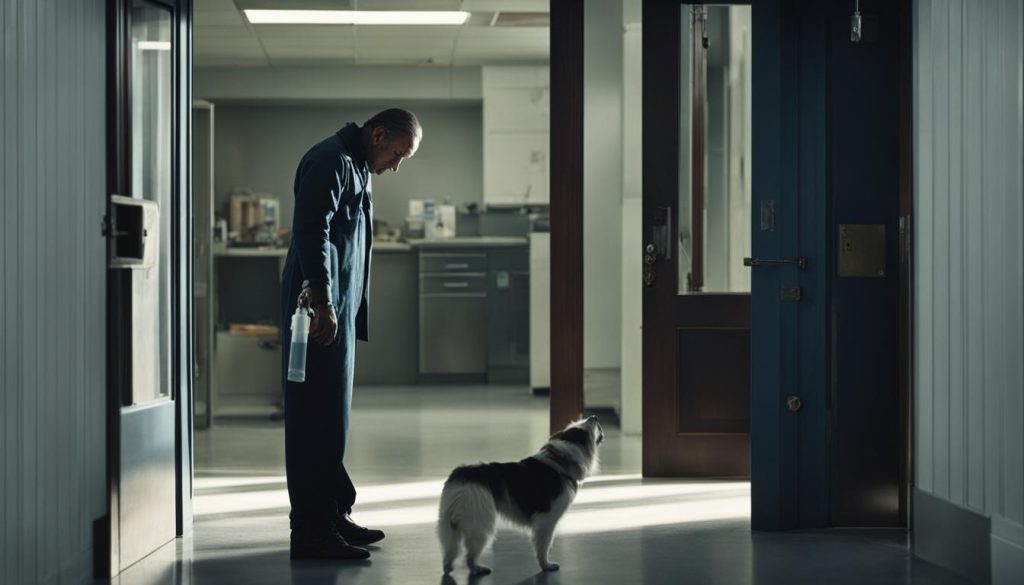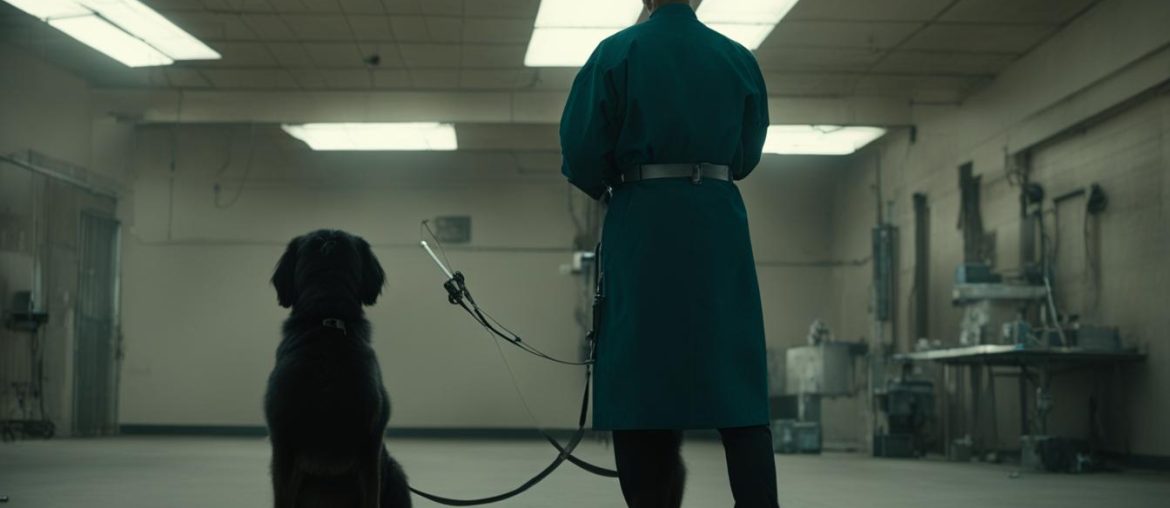Euthanizing a dog for aggressive behavior is a complex and controversial topic. The decision to euthanize an aggressive dog is never made lightly and should only be considered as a last resort when there are no other viable options. There is stigma and judgment surrounding this decision, but it is important to provide support and compassion to those who have to make this difficult choice. The topic of behavioral euthanasia has started to be more openly discussed within the training and rescue community, but there is still a long way to go in understanding and addressing this issue.
Key Takeaways:
- Euthanizing an aggressive dog should only be considered as a last resort when no other viable options are available.
- Behavioral euthanasia is the humane ending of a dog’s life due to severe behavioral issues, such as aggression or extreme anxiety.
- Seek professional help from certified canine behavior consultants or board-certified veterinary behaviorists when dealing with an aggressive dog.
- Before considering euthanasia, explore alternatives such as strict environmental management, training, behavior modification, and rehabilitation programs.
- It is crucial to prioritize the safety and well-being of everyone involved in managing aggressive dog behavior.
What is Behavioral Euthanasia?

Behavioral euthanasia is a difficult and controversial decision made by pet owners and veterinary professionals when a dog’s severe behavioral issues, such as aggression or extreme anxiety, significantly impact their quality of life. This humane ending of a dog’s life is performed by a veterinarian and should only be considered as a last resort when all other safe alternatives have been explored and deemed not viable. The decision to euthanize a dog for behavior problems is never taken lightly and requires careful consideration and ethical guidelines.
Behavioral euthanasia protocols are followed by veterinarians to ensure that the decision is based on thorough evaluation and assessment of the dog’s behavior, medical history, and environment. The process involves discussions with the dog owner to understand the extent of the behavioral problems and the impact on the dog’s well-being and safety. The veterinarian considers the potential risks the dog poses to people and other animals, as well as the dog’s overall quality of life.
It is important to note that behavioral euthanasia is not a means of punishment or blame. Instead, it is a compassionate choice made with the best interests of the dog in mind. The decision to euthanize a dog for behavior problems is a deeply personal and emotional one, often accompanied by feelings of guilt and sadness. Seeking support from professionals and connecting with others who have gone through similar experiences can provide guidance and a sense of understanding during this challenging time.
The Ethical Dilemma
“The decision to euthanize a dog for behavior problems is never taken lightly and requires careful consideration by both the dog owner and the veterinary professionals involved.”
Behavioral euthanasia presents ethical dilemmas that require a delicate balance between ensuring the safety of people and other animals and respecting the well-being of the dog. It is essential for veterinary professionals to approach each case with empathy and compassion, providing support and guidance to the dog owners throughout the decision-making process. The goal is to prioritize safety while exploring all available options and considering the impact on the dog’s quality of life. By navigating these complex ethical considerations, veterinary professionals strive to make the most humane and responsible choices for aggressive dogs.
Putting a Dog Down for Aggressive Behavior

Dealing with an aggressive dog is a challenging and often distressing situation. When a dog exhibits extreme or unpredictable aggressive behavior, it is crucial to seek professional help from a certified canine behavior consultant or a board-certified veterinary behaviorist. These experts have the knowledge and experience to assess the risk factors and evaluate the options for managing the aggression.
Euthanasia should only be considered as a last resort when the dog poses a high risk to the safety of people or other pets, and when all other alternatives have been explored and deemed not viable. The decision to euthanize an aggressive dog is never taken lightly and requires careful consideration by both the dog owner and the veterinary professionals involved. It is essential to prioritize the safety and well-being of everyone involved.
When managing aggressive dogs, professionals may employ various techniques and strategies, such as behavior modification programs, training protocols, and strict environmental management. The goal is to address the underlying causes of the aggression and provide the dog with the necessary tools to behave appropriately. It is important to remember that each dog is unique, and the approach to managing aggression should be tailored to the individual dog’s needs.
| Alternatives to Euthanizing Aggressive Dogs | Benefits |
|---|---|
| Strict environmental management | Reduces the likelihood of incidents and promotes safety |
| Training and behavior modification | Empowers the dog to learn new behaviors and improve overall behavior |
| Rehabilitation programs | Provides dogs with the opportunity to develop new skills and behaviors |
Before considering behavioral euthanasia, it is crucial to exhaust all possible alternatives. Strict environmental management can help prevent incidents and maintain safety by carefully managing the dog’s living environment and implementing safety protocols. Training and behavior modification, under the guidance of a professional trainer or behaviorist, can empower the dog to learn new behaviors and address aggression. Rehabilitation programs can provide dogs with the opportunity to develop new skills and behaviors, ultimately improving their overall behavior and quality of life.
It is important to approach the decision to euthanize an aggressive dog with empathy, compassion, and a thorough exploration of all available options. By seeking professional help, implementing appropriate management techniques, and considering alternatives to euthanasia, it may be possible to manage and rehabilitate aggressive behavior in dogs, ensuring their safety and well-being.
References:
- Smith, J. W. (2020). Understanding Aggression in Dogs. Veterinary Clinics: Small Animal Practice, 50(5), 879-893.
- Horwitz, D. F., & Landsberg, G. M. (2010). Managing Common Canine Behavior Problems. Veterinary Clinics of North America: Small Animal Practice, 40(2), 285-298.
- Overall, K. L., Dunham, A. E., & Frank, D. (2001). Frequency of nonspecific clinical signs in dogs with separation anxiety, thunderstorm phobia, and noise phobia, alone or combined. Journal of the American Veterinary Medical Association, 219(4), 467-473.
Alternatives to Behavioral Euthanasia
When faced with the challenging decision of euthanizing an aggressive dog, it is important to explore all possible alternatives before making a final determination. Strict environmental management is one such alternative that focuses on managing the dog’s living environment and implementing safety protocols. By creating a secure and controlled environment, the risk of incidents can be reduced, ensuring the safety of both the dog and those around them.
Aggressive dog training and behavior modification should also be considered as an alternative to behavioral euthanasia. With the guidance of a professional trainer or behaviorist, a customized training plan can be developed to address the underlying causes of aggression and modify the dog’s behavior. This approach aims to teach the dog alternative, more appropriate behaviors and can be highly effective in reducing aggressive tendencies.
Additionally, rehabilitation programs offer another alternative to euthanizing an aggressive dog. These programs provide dogs with the opportunity to learn new behaviors and improve their overall behavior through structured training and socialization. Rehabilitation can be a transformative process, allowing the dog to gain the skills and confidence necessary to live a balanced and non-aggressive life.
| Alternative | Description |
|---|---|
| Strict Environmental Management | Focuses on managing the dog’s living environment and implementing safety protocols. |
| Aggressive Dog Training and Behavior Modification | Customized training plan to address the underlying causes of aggression and modify behavior. |
| Rehabilitation Programs | Structured training and socialization to help the dog learn new behaviors and improve overall behavior. |
It is important to exhaust all possible alternatives before considering behavioral euthanasia. Each dog and situation are unique, and the success of these alternatives may vary. However, by exploring these options, dog owners can give their pets the best chance at a happy and non-aggressive life.
Finding Support
Dealing with an aggressive dog can be emotionally and mentally challenging. It is crucial to seek support from professionals, such as certified canine behavior consultants and veterinary behaviorists, who can provide guidance and assistance in managing and treating aggressive behavior. Additionally, connecting with support groups or online communities that specialize in aggressive dogs can help provide emotional support and a sense of understanding from others who have gone through similar experiences. Remember, you are not alone in facing this difficult situation.
When seeking help for an aggressive dog, it is important to find professionals who have experience and expertise in dealing with aggression. Certified canine behavior consultants and veterinary behaviorists can offer valuable insights and customized treatment plans based on the specific needs of your dog. They can help you understand the underlying causes of aggression and provide guidance on managing and modifying your dog’s behavior.
Support groups and online communities can also provide a valuable source of emotional support. Connecting with others who have dealt with aggressive dogs can help you navigate the challenges and complexities of this situation. These communities offer a safe space to share experiences, ask questions, and seek advice from those who have been through similar situations. Remember to approach these communities with an open mind and be respectful of others’ experiences and perspectives.
Dealing with an aggressive dog can be overwhelming, but seeking support is essential. Reach out to professionals and connect with others who can offer guidance and understanding. Remember, there is help available, and you don’t have to face this challenge alone.
Support Resources for Aggressive Dogs:
- Certified Canine Behavior Consultants
- Veterinary Behaviorists
- Local Support Groups
- Online Communities
Remember, seeking help is a sign of strength and love for your dog. Don’t hesitate to reach out and find the support you and your furry friend need.
| Resource | Description |
|---|---|
| Certified Canine Behavior Consultants | These professionals specialize in dog behavior and can provide guidance and training tailored to your dog’s specific needs. |
| Veterinary Behaviorists | These veterinarians have additional training in animal behavior and can offer expert advice and treatment options for aggressive dogs. |
| Local Support Groups | Support groups in your community can provide a safe space to share experiences, receive emotional support, and learn from others who have dealt with similar situations. |
| Online Communities | Online forums and groups dedicated to aggressive dogs can provide a vast network of support and resources, enabling you to connect with others who understand and can offer advice. |
The Complexity of Aggression Cases

Aggression cases in dogs are multifaceted and require a comprehensive evaluation of various factors. These include the dog’s behavior patterns, medical history, and environment. Understanding the root causes of aggression, such as fear, anxiety, or territoriality, is crucial in developing effective strategies for managing and addressing this behavior. Working with professionals experienced in dealing with aggression is essential in order to develop a tailored treatment plan that takes into account the unique circumstances of each dog.
Managing aggressive dogs requires a holistic approach that combines behavior modification, environmental management, and, in some cases, medication. Behavior modification techniques, implemented under the guidance of a professional trainer or behaviorist, can help modify the dog’s response to triggers and reinforce positive behaviors. Environmental management involves creating a safe and structured living environment for the dog, minimizing potential triggers and opportunities for aggressive behavior.
In some instances, medication may be prescribed to help address underlying anxiety or fear that contributes to aggression. This should always be done under the supervision of a veterinarian and in conjunction with behavior modification techniques. It is important to note that medication alone is rarely a standalone solution and should be used as part of a comprehensive treatment plan.
Table: Common Aggression Triggers and Treatment Approaches
| Aggression Trigger | Treatment Approach |
|---|---|
| Resource Guarding | Counter-conditioning, desensitization, and structured feeding routines |
| Fear Aggression | Desensitization and counter-conditioning, environmental management, and medication if necessary |
| Territorial Aggression | Behavior modification, training exercises focused on impulse control, and environmental management |
| Reactive Aggression | Desensitization and counter-conditioning, redirecting focus through positive reinforcement training |
It is important to recognize that managing aggressive behavior in dogs is an ongoing process that requires patience, consistency, and a commitment to the dog’s well-being. It is crucial to seek professional guidance and support, as they have the knowledge and experience to develop effective strategies for managing and improving the dog’s behavior. With the right approach and a well-rounded treatment plan, many aggressive dogs can lead happy, fulfilling lives.
Ethical Considerations in Euthanizing Aggressive Dogs
When it comes to euthanizing an aggressive dog, ethical considerations play a significant role in the decision-making process. It is a complex and sensitive matter that requires careful thought and understanding of the various perspectives involved. The wellbeing and safety of both the dog and the people around them must be taken into account.
First and foremost, the ethical implications of euthanizing an aggressive dog revolve around the principle of minimizing harm. If a dog poses a significant risk to the safety of humans or other animals and all other options have been exhausted, euthanasia may be considered as a necessary measure to prevent future harm.
“The decision to euthanize an aggressive dog is never easy, but it is crucial to prioritize the safety and wellbeing of everyone involved. It is a decision that is made with compassion and in the best interests of all parties.”
Additionally, ethical considerations include the quality of life for the dog. Severe aggression can lead to a diminished quality of life, causing distress and suffering for the animal. In these cases, euthanasia may be seen as a humane choice to alleviate the dog’s pain and ensure their welfare.
| Ethical Considerations in Euthanizing Aggressive Dogs | |
|---|---|
| Ethical Implication | Explanation |
| Minimizing Harm | Euthanasia may be necessary to prevent future harm if all other options have been exhausted. |
| Quality of Life | Euthanasia may be seen as a humane choice to alleviate the dog’s pain and suffering. |
It is important for professionals involved in the euthanasia process, such as veterinarians and behavior consultants, to approach each case with empathy and provide support to the dog owners. They must ensure that all available options have been explored, providing guidance and helping owners make informed decisions.
Understanding Risk Factors
Assessing the risk factors associated with aggressive dog behavior is crucial in determining the appropriate course of action. Several factors need to be considered when evaluating the level of risk posed by an aggressive dog. These factors include the dog’s medical history, age, breed, and behavior patterns. By taking these factors into account, professionals can better understand the potential for harm to both humans and other animals.
One important risk factor to consider is the dog’s medical history. Certain medical conditions or physical ailments can contribute to aggressive behavior in dogs. For example, pain or discomfort caused by an underlying health issue may lead to increased aggression. It is essential to rule out any potential medical causes or underlying health conditions that may be influencing the dog’s behavior.
Another factor to assess is the dog’s age. Younger dogs may be more prone to impulsive and unpredictable behavior, while older dogs may exhibit aggression due to fear or pain associated with age-related issues. Understanding the age-related factors that contribute to aggressive behavior can help determine the most appropriate interventions and management strategies.
| Factors | Explanation |
|---|---|
| Medical history | Assess any underlying health issues that may contribute to aggression. |
| Age | Consider the dog’s age-related tendencies and potential triggers. |
| Breed | Some breeds may have a genetic predisposition to aggressive behavior. |
| Behavior patterns | Evaluate the dog’s past and current behavior to identify patterns and triggers. |
The dog’s breed is another important factor to take into account. While it is essential to recognize that not all dogs of a particular breed are aggressive, some breeds may have a genetic predisposition to display aggressive behavior. Understanding breed-specific traits and tendencies can help professionals develop targeted strategies for managing and reducing aggression.
Lastly, evaluating the dog’s behavior patterns is crucial in assessing risk factors. By examining the dog’s past and current behavior, professionals can identify patterns and triggers that may contribute to aggressive episodes. This information helps in developing behavior modification plans and implementing appropriate management techniques to reduce the risk of aggressive behavior.
Quality of Life Considerations

When deciding on the euthanasia of an aggressive dog, assessing their quality of life is of utmost importance. Severe aggression can greatly impact a dog’s well-being and ability to lead a fulfilling life. Factors such as overall happiness, stress levels, and the ability to engage in normal dog behaviors should be carefully evaluated.
If aggressive behavior significantly compromises a dog’s quality of life and there are no viable alternatives for managing or rehabilitating the aggression, euthanasia may be a humane and compassionate choice. It is crucial to prioritize the dog’s welfare and prevent unnecessary suffering.
Factors to Consider in Assessing Quality of Life:
- Dog’s overall happiness and mental well-being
- Level of stress and anxiety the dog experiences
- Ability to engage in normal dog behaviors
- Impact on the dog’s physical health
- Evaluation of pain or discomfort caused by aggression-related incidents
By thoroughly evaluating these factors, dog owners and professionals can make a well-informed decision regarding the dog’s quality of life and whether euthanasia is the most humane option.
| Pros | Cons | |
|---|---|---|
| Euthanasia | – Provides relief from severe aggression | – Loss of a beloved pet |
| Other Options | – Potential for behavior improvement | – Risk of harm to others |
Ultimately, the decision should be made with compassion and in the best interest of the dog, considering their individual circumstances and the impact of their aggression on their overall well-being.
Addressing Guilt and Emotional Challenges

Dealing with the decision to euthanize an aggressive dog can evoke a range of intense emotions, including guilt, sadness, and grief. The love and attachment we feel for our pets make this already difficult decision even harder. It’s essential to recognize and acknowledge these emotions as a natural part of the process. Seeking emotional support from professionals, friends, and family who understand the complexity of the situation can provide comfort and guidance during this challenging time.
Remember, the decision to euthanize an aggressive dog is not taken lightly. It is made with the intention of prioritizing safety and well-being for both the dog and the people involved. By seeking professional guidance and exploring all available options, you are demonstrating your commitment to doing what is best for everyone.
Understanding that euthanasia is a humane choice when all alternatives have been exhausted can help alleviate some of the emotional burden. It is important to focus on the fact that you are making a difficult decision out of love and compassion for your pet. Recognizing that you have considered the welfare and quality of life of your dog throughout this process can provide reassurance and peace of mind.
The Importance of Professional Support
Seeking professional support during this challenging time is crucial. Veterinarians, certified canine behavior consultants, and support groups specializing in aggressive dogs can provide guidance, understanding, and a safe space to share your feelings. These professionals have the experience and expertise to help you navigate the emotional challenges associated with euthanizing an aggressive dog.
Coping with Loss and Grief
After euthanizing an aggressive dog, it’s normal to experience a profound sense of loss and grief. Allow yourself time and space to grieve and process your emotions. Engaging in self-care activities, such as journaling, exercising, or seeking therapy, can be beneficial in navigating the grieving process. Remember that healing takes time, and it’s important to be patient and kind to yourself throughout this journey.
Learning from Personal Experiences

When it comes to making the difficult decision to euthanize an aggressive dog, personal experiences can provide valuable insights and perspectives. Hearing the stories of others who have gone through similar situations can help individuals facing this decision feel less alone and provide guidance in navigating the complexities of such cases. These personal accounts shed light on the emotional challenges, ethical considerations, and practical difficulties involved in euthanizing aggressive dogs.
Through personal experiences, we can gain a deeper understanding of the factors that go into making this decision. Each story is unique, but they all share a common thread of love and concern for the welfare of the dog and the safety of those around them. It is through these narratives that we can recognize the weight of the decision and the impact it has on both the dog owner and the professionals involved.
“It was the most agonizing decision I have ever made, but I knew it was the right one for my dog and our family. We had exhausted all other options and had tried every training and rehabilitation program available. In the end, his aggressive behavior posed a significant risk to our children, and we had to prioritize their safety. It was a heartbreaking choice, but it was made out of love and a desire to prevent any harm.”
Personal experiences also highlight the importance of seeking support and guidance throughout this process. Connecting with others who have faced similar situations can provide emotional support, understanding, and validation. Online communities, support groups, and professional networks can offer a sense of community and comfort during this challenging time.
Euthanizing an aggressive dog is an incredibly difficult decision to make, and personal experiences remind us of the gravity and complexity of this choice. By sharing our stories and learning from one another, we can strive to approach these situations compassionately, ethically, and with the utmost care for the well-being of all involved.
Wrapping Up
In conclusion, the decision to euthanize an aggressive dog is one that should never be taken lightly. It is a complex and deeply personal choice that should only be considered after all other options have been thoroughly explored and deemed not viable. The well-being and safety of both the dog and the people involved should always be the top priority.
Throughout this article, we have discussed the ethical considerations, alternatives, and challenges associated with euthanasia for aggressive dogs. We have highlighted the importance of seeking professional guidance from certified canine behavior consultants and veterinary behaviorists, as well as the value of connecting with support groups and online communities for emotional support.
Ultimately, euthanasia for an aggressive dog may be a compassionate and humane choice when all other avenues have been exhausted. It is a decision that requires empathy, compassion, and careful consideration of the dog’s quality of life. By prioritizing safety and taking into account the specific circumstances of each case, we can strive to make the best decision for everyone involved.
FAQ
Will a vet put down an aggressive dog? Ethical best practices
Euthanizing an aggressive dog is a complex decision that should only be considered as a last resort when there are no other viable options. Veterinary professionals approach each case with careful consideration, prioritizing the safety and well-being of both the dog and the people involved.
What is Behavioral Euthanasia?
Behavioral euthanasia is the humane ending of a dog’s life due to severe behavioral issues, such as aggression or extreme anxiety. It is performed by a veterinarian and should only be considered when the dog’s quality of life is significantly affected and there are no other safe alternatives.
What are the alternatives to euthanizing an aggressive dog?
Before considering behavioral euthanasia, alternatives such as strict environmental management, training and behavior modification, and rehabilitation programs should be explored. These alternatives aim to manage and improve the dog’s behavior while prioritizing safety.
How can I find support for dealing with an aggressive dog?
Seek professional help from certified canine behavior consultants or veterinary behaviorists who can provide guidance and assistance in managing and treating aggressive behavior. Connecting with support groups or online communities can also offer emotional support from others who have faced similar challenges.
What factors need to be considered when assessing an aggressive dog’s risk?
Factors such as the dog’s medical history, age, breed, and behavior patterns should be taken into account when assessing the risk associated with aggressive behavior. Evaluating the potential for harm to both humans and other animals helps determine the appropriate course of action.
What should be considered when evaluating a dog’s quality of life before euthanasia?
When evaluating a dog’s quality of life, factors such as overall happiness, level of stress and anxiety, and ability to engage in normal dog behaviors should be considered. If the dog’s quality of life is greatly compromised due to their aggression, euthanasia may be a humane choice.
How can I address feelings of guilt and emotional challenges when considering euthanasia for an aggressive dog?
It is common to experience guilt, sadness, and grief when considering euthanasia for an aggressive dog. Seeking emotional support from professionals, friends, and family who understand the complexity of the situation can help alleviate some of these emotions and provide guidance during this difficult time.
Are there personal experiences that can provide insights into euthanizing aggressive dogs?
Personal stories from those who have made the decision to euthanize an aggressive dog can provide valuable insights and perspectives. These stories can help individuals facing this decision feel less alone and offer support and guidance.






